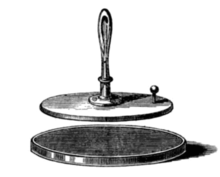Description and operation of Electrophorus
– Electrophorus consists of a dielectric plate and a metal plate with an insulating handle.
– The dielectric plate is charged through the triboelectric effect.
– When the metal plate is placed onto the dielectric plate, charges in the metal plate separate.
– The electrophorus is a manually operated electrostatic generator.
The source of the charge in Electrophorus
– Charge conservation is maintained while using an electrophorus.
– The metal plate of the electrophorus ends up with either a positive or negative charge.
– The opposite charge is stored in another object after grounding.
– Additional energy put into the system increases the voltage of the metal plate.
Additional information about Electrophorus
– The charge on the dielectric plate will eventually leak through the surface or atmosphere.
– German scientist Georg Christoph Lichtenberg built the largest example of an electrophorus.
– Lichtenberg used electrophorus discharges to create Lichtenberg figures.
Related concepts
– Electret is related to electrophorus.
References
– Pancaldi’s book ‘Volta, Science and Culture in the Age of Enlightenment’
– Jones’ website on electrophorus and accessories
– Schiffer’s book ‘Draw the Lightning Down: Benjamin Franklin and electrical technology in the Age of Enlightenment’
– Fleming’s article on electrophorus in the Encyclopædia Britannica
– Harris’ book ‘A Treatise on Frictional Electricity in Theory and Practice’ Source: https://en.wikipedia.org/wiki/Electrophorus
In electromagnetism, an electrophorus or electrophore is a simple, manual, capacitive, electrostatic generator used to produce charge via the process of electrostatic induction. A first version of it was invented in 1762 by Swedish professor Johan Carl Wilcke. Italian scientist Alessandro Volta improved and popularized the device in 1775, and is sometimes erroneously credited with its invention. The word electrophorus was coined by Volta from the Greek ήλεκτρον, elektron, and φορεύς, phoreus, meaning 'electricity bearer'.

